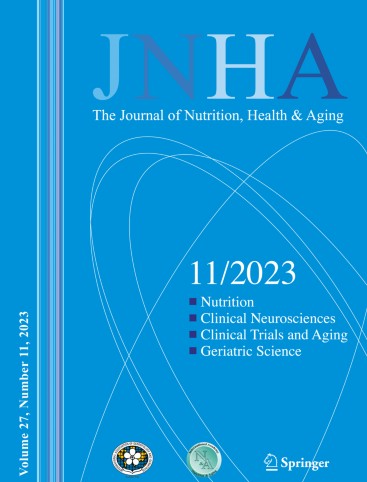Normative data of ultrasound quadriceps rectus femoris geometric values. The ECOSARC-2 Study
IF 4
3区 医学
Q1 GERIATRICS & GERONTOLOGY
引用次数: 0
Abstract
Objectives
To describe geometric muscle ultrasound normative values of Quadriceps Rectus Femoris (QRF) at mid-thigh in Spanish community-dwelling older adults. Secondary objectives included evaluating the associations between ultrasound measurements and physical function, muscle strength, frailty, and dependency in basic activities of daily living.
Design
Cross-sectional study.
Setting
Outpatient clinics of Geriatric Departments at seven University Hospitals and three Primary care settings of Spain.
Participants
424 community-dwelling persons ≥70 years old.
Measurements
Ultrasound measurements were acquired using a Clarius® L7 HD3 probe. QRF thickness (QRFT), QRF area (QRFA), subcutaneous adipose thickness (SAT), total mid-thigh thickness (TTT), and pennation angle (PA) were calculated. Normative values are provided, and associations with comorbidity, dependency, strength, frailty and physical function are described.
Results
Mean age was 81.5 years (range 70−99), 66.7% were female. Mean Barthel index was 93 (SD 11), and mean FRAIL score was 1.1 (1.2). Mean SPPB was 8.7 (SD 2.9) and mean grip strength was 20.7 (8.0). Median values of QRFT, QRFA, SAT, TTT, and PA for women and men were 14.2 / 16.1 mm, 5.4 / 6.4 cm2, 15.1 / 9.2 mm, 41.1 / 40.1, and 10.0 / 10.6 respectively. Functional variables were strongly associated with QRFT, QRFA, and TTT in men, and PA with SPPB in both sexes.
Conclusions
The ECOSARC-2 study provides normative values of geometric mid-thigh muscle ultrasound parameters in community-dwelling older adults. These values are essential for determining sex-specific cut-off points for conditions such as sarcopenia, frailty, malnutrition, and for predicting relevant outcomes.
股直股四头肌超声数据的几何值。ecoosarc -2研究
目的探讨西班牙社区老年人大腿中部股直股四头肌(QRF)的几何肌肉超声正常值。次要目的包括评估超声测量与身体功能、肌肉力量、虚弱和日常生活基本活动依赖性之间的关系。DesignCross-sectional研究。西班牙七所大学医院和三所初级保健机构的老年科门诊。参与者424名≥70岁的社区居民。测量使用Clarius®L7 HD3探头进行超声测量。计算QRF厚度(QRFT)、QRF面积(QRFA)、皮下脂肪厚度(SAT)、大腿中部总厚度(TTT)、笔尖角(PA)。提供了规范值,并描述了与合并症、依赖性、力量、脆弱和身体功能的关联。结果平均年龄81.5岁(70 ~ 99岁),女性占66.7%。平均Barthel指数为93 (SD 11),平均虚弱评分为1.1(1.2)。平均SPPB为8.7 (SD 2.9),平均握力为20.7(8.0)。女性和男性QRFT、QRFA、SAT、TTT和PA的中位值分别为14.2 / 16.1 mm、5.4 / 6.4 cm2、15.1 / 9.2 mm、41.1 / 40.1和10.0 / 10.6。功能变量与男性QRFT、QRFA和TTT密切相关,而PA与两性SPPB密切相关。结论ECOSARC-2研究提供了社区老年人大腿中部肌肉几何超声参数的规范性值。这些值对于确定肌肉减少症、虚弱、营养不良等疾病的性别分界点和预测相关结果至关重要。
本文章由计算机程序翻译,如有差异,请以英文原文为准。
求助全文
约1分钟内获得全文
求助全文
来源期刊
CiteScore
7.80
自引率
3.40%
发文量
136
审稿时长
4-8 weeks
期刊介绍:
There is increasing scientific and clinical interest in the interactions of nutrition and health as part of the aging process. This interest is due to the important role that nutrition plays throughout the life span. This role affects the growth and development of the body during childhood, affects the risk of acute and chronic diseases, the maintenance of physiological processes and the biological process of aging. A major aim of "The Journal of Nutrition, Health & Aging" is to contribute to the improvement of knowledge regarding the relationships between nutrition and the aging process from birth to old age.

 求助内容:
求助内容: 应助结果提醒方式:
应助结果提醒方式:


